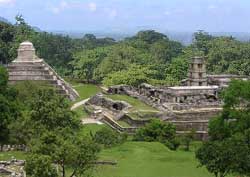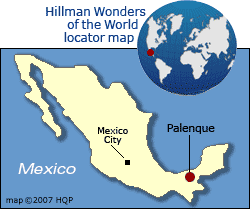Palenque
 Why
Palenque
is special
Why
Palenque
is specialThe Palenque archaeological site has well-preserved Mayan ruins. It is nestled in a gorgeous steep-hill landscape blanketed by a lush tropical forest.
Palenque tips and insights
How to pronounce
Palenque: pah-LEHN-kay
History in brief
Palenque dates back to at least about 100 BC. Its glory days were from 600 to 800 AD. Within a 100 years, the city-state collapsed and was abandoned to the encroaching forest.
Top 2 Palenque attractions
-
Temple of Inscriptions
This building (see left side of photo) is best known for its long, stone-carved glyphic story board, a Mayan masterpiece. And, Pacal, the greatest of Palenque rulers, is interned underneath the edifice.
- Palace
It sports a distinctive four-story tower and has a rambling complex of rooms and courtyards. See right side of photo.
Views
Some temples offer great views of Palenque and of the luxuriant forested plain stretching to the Gulf Coast. But their steps are steep and short-treaded, so wear comfortable, good-grip shoes.
High altitude
Many temple climbers run out of breath, not realizing that Palenque is nearly 3,000 meters (9,000 feet) above sea level.
Climate
It is typically quite warm, humid and rainy, so wear light cotton clothing and bring hat and rain gear. Sun screen and insect repellent should also be on your packing list.
Excavations
Archaeologists have uncovered only a small fraction of the structures.
Getting there
Most visitors arrive via the Villahermosa airport. They then take a two-hour road trip to Palenque. Many tour busses make Palenque a daytrip out of Villahermosa.
How to avoid the crowds
I recommend staying overnight in a hotel in the town just outside of Palenque so you can explore the site when the gates open at 8 in the morning. You'll beat the tour-bus crowds and the sweltering midday heat. As a bonus, you may see the fog and mist mystically swirling around. Another low-tourist period is from 3 to 5 p.m., before Palenque closes.
Location map



